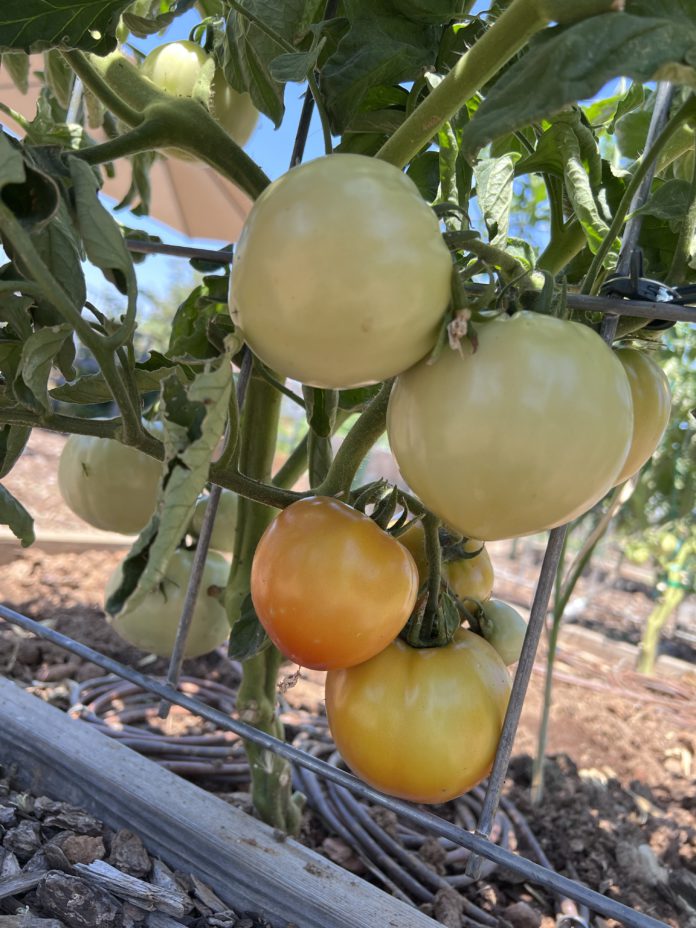Delicious whichever way you eat them!
By Madhvika Singh
I have been planting tomatoes for the past twenty years in my home garden. The joy of fresh harvest, superior flavor and being able to experience unique varieties always exceeds the challenges that can sometimes produce a less-than-perfect tomato.
In growing tomatoes, some important considerations are variety, location, days to maturity and growth habit. Based on growth habits, tomatoes are largely classified as determinate and indeterminate. Determinate tomatoes are bushy and compact, producing much of their fruit all at once. They grow from three to about five feet, are often early ripening and produce fruit mainly concentrated at one time. Because of their compact nature, they can be easily grown in containers, patios and balconies. I grow these to make tomato-based sauces for freezing as I get all my harvest together. Indeterminate varieties are vining types that need sturdy support structures. They grow and bear flowers and fruit until disease or frost kills them. These serve our household’s day-to-day tomato needs.
When it’s time to plant, a trip to my local nursery feels like being a child in a toy store. While the variety to choose from is tempting, I select types that are reliable producers and some new ones. I prefer not to start from seeds as I become impatient waiting for them to put on leaves. At the nursery, I pick transplants that are sturdy, thick-stemmed, dark green and six to eight inches tall. Choices are endless, from cherry to grape to paste to slicing, and from hybrids to heirlooms.
When it comes to selecting a space, tomatoes love to be planted in full sun all day, although occasional heat waves can cause scalding on fruit and cause flowers to drop, leading to a poor fruit yield. Poor yield can also be due to excess nitrogen or planting the wrong variety for your area. Plant tomatoes deep into the soil and press the soil firmly around them. Deep planting encourages additional roots to develop, creating a strong root system. Since I add compost to the planting site at the beginning of the growing season, I do not add more fertilizer, but rather add side dressings of tomato fertilizer throughout the growing season every few weeks. If I see plants missing foliage rigor, I give them a nitrogen-based fertilizer.
I add the support structure at planting time. Sturdy metal cages work well for compact tomato varieties. I find do-it-yourself cattle panel arches are a practical way to trellis, especially with indeterminate tomato varieties in my garden. Growing them up a structure helps keep pests and diseases away. Watering away from the base of the plant and pruning leaves and stems from the base so that the leaves do not drip dew on to the stem can prevent diseases like early blight. Also, snip away leaves that might cause crowding and constriction of air flow.
While no plant is completely immune to disease, many hybrids are more resistant than heirloom varieties. Letters like V, F and N on seed packets and plant labels can help identify disease resistance. V stands for verticillium wilt, F for fusarium wilt and N for nematodes. Another abbreviation is TMV, indicating resistance to tobacco mosaic virus. Visually checking plants for pest eggs or larva and removing them allows for a conservative approach to pest control. When it comes to pests, ones that destroy fruit and leaves are one thing, but rodents like gophers that chew away the roots are the most damaging in my garden. A big plant can die in minutes. Growing plants in a raised bed with hardware fabric underneath creates a barrier against rodents.
The time to pick tomatoes also varies from gardener to gardener. Some pick when the fruit is slightly unripe and others at the peak of ripening. I’ve found that tomatoes taste best when picked at the peak, although if I go out of town, I will pick them sooner with the vines and let them ripen indoors. The skins do get a bit leathery, but the tomatoes can be blanched to remove their skins and used in soups and sauces.
Grown tomatoes requires time, energy, pest control and timely harvesting, and storing the bounty also requires effort and planning. Freezing them in halves or quarters, canning whole or as paste and sauces allows for later use. As a home gardener I try to achieve balance between imperfections in produce like cracks or scalds, pest management and the amount of time that I can give to my garden. To me gardening is not only about growing but also “cultivating” a connection to our roots.
While we use a lot of cooked tomatoes in soups and sauces, we also love using them fresh in salsas and sandwiches. Below are some ways to enjoy fresh tomatoes that don’t require a lot of time and equipment.
Dice up all the different varieties of tomatoes your garden has to offer. Ripe ones bring out the best flavor. Add finely chopped fresh cilantro leaves, onions, jalapenos, a squeeze of lime or lemon juice and a dash of salt and pepper. My personal favorite addition is throwing in some cubed pineapple! Enjoy with your favorite corn chips.
To diced-up tomatoes, add finely chopped garlic and fresh basil leaves, salt, pepper and olive oil, if desired. Gently mix ingredients for flavors to incorporate. Use as a topping on a lightly toasted sourdough baguette!
Note: This article gives an overview of growing plants, sun and soil requirements, moisture needs etc. Plant health and growth will vary based on various factors. This article is intended for gardening and culinary inspiration only. Please consult your healthcare provider should you have any questions or concerns about adding any new foods or ingredients to your diet.




